| Plant of the Month |
Dicentra -
Bleeding Heart
Beautiful spring blooming perennials
Jewels of the Shade!
Dicentra spectabilis, more commonly known as "Old Fashioned Bleeding Heart", is one of the most strikingly beautiful spring blooming perennials.
 |
| It's easy to see why they are called "Bleeding Hearts" |
Beginning in April,
Dicentra spectabilis is covered with deep pink and white heart-shaped flowers that dangle from gracefully arching branches and if kept evenly moist, it can continue to bloom from 4 to 6 weeks. It forms a beautiful, airy mounded clump up to 36" tall and 36" wide.
 |
Dicentra spectabilis is beautiful
in the shade garden. |
A striking
Dicentra spectabilis cultivar that really stands out in the shade garden is 'Gold Heart' which has vivid golden foliage with the same deep pink heart-shaped flowers as the species. Very cool!
 |
|
Dicentra spectabilis 'Gold Heart'
|
White bleeding hearts?
There is also a white blooming cultivar of the old-fashioned bleeding heart,
Dicentra spectabilis 'Alba'. This is stunning in a lightly shaded garden.
 |
|
Dicentra spectabilis 'Alba'
|
If you prefer a smaller, more compact bleeding heart that blooms through most of the season, try one of the everblooming varieties. These will bloom fairly continuously especially if the spent flower stems are removed.
Dicentra 'Luxuriant' is a nice everbloomer with fern-like green foliage and deep pink flowers that bloom from May through September. 'King of Hearts' is another everblooming variety with bold cherry pink flowers that contrast nicely with its fringed blue-green foliage.
 |
|
Dicentra 'King of Hearts'
|
Culture
Dicentra flourishes in humus-rich, evenly moist soil. In warmer climates, they do best when planted in an area that receives morning sun and afternoon shade. In more northern zones, they prefer more sun but it is still important to keep the soil moist.
During the heat of summer,
Dicentra spectabilis begins a dormant period. At this time, the foliage will begin to turn yellow and die back. This is normal for these plants and they can be cut back to the ground at this time. Be sure to plant some summer and fall blooming perennials around them to fill the void after they are cut back. The everblooming varieties do not generally go dormant.
Great Companions
All species of Dicentra are great in combination with spring-blooming bulbs,
Epimedium,
Heuchera, and
Polemonium in a light shade border or with ferns, hosta, and
Polygonatum
in a woodland garden.
Try some of these delightful perennials in your garden this year and bring some good "old-fashioned" blooms into your landscape!
|
|
Join Our List
|

|
|
Save The Date!
|
A brand new Home Show is coming to Williamsburg, VA
March 28 - 29th
The College of William & Mary
William & Mary Hall
Affording the luxury of conveniently shopping the area's best contractors and retailers in one location, the Home Show is designed for homeowners in any stage of remodeling and decorating their homes. With the combination of seeing new products, experiencing hands on demonstrations, and receiving professional advice, the Home Show inspires homeowners with countless ideas to enhance their home and overall value.
For homeowners whose passion is their yard, the
Green Thumb Theater will host a series of demonstrations and seminars on landscaping and gardening featuring Mark Viette, syndicated talk Show host of "In the Garden" along with various experts from the James City County/Williamsburg Master Gardeners' Program and other regional experts.
Mark will speak Saturday, March 28th at 2:00 PM
"Gardening Made Easy"
Mark will discuss how not too kill your plants, proper watering, pruning, soil preparation, planting and mulching. Other topics will include backyard vegetable gardening and selecting "Fool-Proof Plants" also known as 'Purple Thumb Plants' anyone can grow.
The first 50 attendees to Mark's talk will each receive a named Daylily hybridized by the Viette's (value-$20).
Visit the Williamsburg Home Show for more details!
We hope to see
you there!
|
| Gardening Questions? |
Listen to Andre
on the radio every
Saturday morning
from 8:00-11:00 on
"In the Garden
with Andre Viette"
You can also listen to podcasts.
|
Viette Discussion Board
|
Can't get through
on the radio?
Visit our
Discussion Board for answers to your gardening questions. Use the convenient search key to see if we have already addressed your problem!
Don't see the answer?
Post your question!
It's EASY, just register as a member.
Don't forget to tell us where you live (city and state) so we can provide a more accurate answer to your question.
|
|
|
| Tip of the Month |
Get Ready to Start Vegetable Seeds Indoors
There are many advantages to starting your own vegetable plants indoors. Although some disadvantages may also exist, these tend to be the result of improper growing conditions and planting procedures.
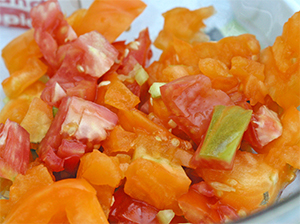 |
|
A colorful mix of tomatoes
makes beautiful salsa
|
By starting your own seeds, you are able to choose plant varieties based on those characteristics which are most important to you. A smorgasbord of fresh tomatoes makes a cheerful sight on the table and to grow a colorful assortment of tomatoes, you almost have to purchase seed and grow the plants yourself.
Click for a
list of seed catalogs.
By carefully choosing the time you start your seeds indoors, you will be able to have transplant-size plants at the ideal planting time in the spring.
S
o ... when should you start your seeds?
This all depends upon where you live and the type of vegetables you grow. Cool season crops like broccoli and cauliflower are more tolerant of cooler temperatures than warm season crops like tomatoes and peppers and can be placed out in the garden earlier in the season. Here is a tip that will help you determine
when to start different vegetable seeds indoors.
Seed Starting Basics
Seeds have certain basic requirements for germination:
 a planting medium (usually a soilless mix) which is well drained and sterile (free from disease, insect pests, and weed seeds) a planting medium (usually a soilless mix) which is well drained and sterile (free from disease, insect pests, and weed seeds)- sufficient amounts of water and air as well as the proper soil and air temperatures (some plants will germinate faster with cooler temperatures)
- sufficient levels of light intensity and duration immediately after germination/sprouting.
Although all of these are important, light is the single most important factor for the success of your seedlings. For this reason, figure out how you will provide sufficient light for your seedlings before you start your seeds.
-
 You can purchase ready to use growing fixtures for starting seeds or create your own growing system with shelves and fluorescent light fixtures. You can purchase ready to use growing fixtures for starting seeds or create your own growing system with shelves and fluorescent light fixtures.
- The important thing is to be able to adjust the height of the light fixture as your seedlings grow. My fluorescent fixtures hang from a series of pulleys so they can be raised and lowered.
|
|
|
Bell pepper seedlings growing under lights
|
Although light is not necessary for germination, it is very important that the young seedlings have adequate light once they emerge. Seedlings will become weak and spindly instead of compact and healthy if the light is insufficient.
- It is best if the light fixture is kept fairly close (within 3"-5") to the top of the growing plants.
- Use a light timer to give your seedlings about 10-14 hours of light each day.
Once they germinate but before they produce their first set of true leaves, it is important to harden off your seedlings to keep them from getting tall and leggy. This can be accomplished by providing cooler temperatures, less humidity, and less moisture. Having a fan blowing softly over your seedlings for a while each day can help strengthen their stems and also reduce humidity that can lead to disease problems like damping off. Be sure to maintain the same amount of light (10-14 hours/day) for your seedlings.
Read my Viette's Views blog post on seed starting:
Seeds - Nature's Little Miracles
|
Did You Know?
|
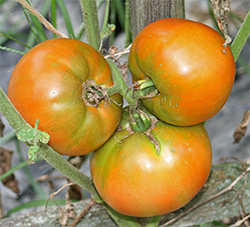
Transplants vs. Direct-sowing
Starting a vegetable garden?
Confused about whether you should start seeds indoors or sow them directly in the garden?
There are advantages and disadvantages to each and the answer really depends upon the individual crop.
- Starting seeds indoors allows you to have more control over the growing environment.
- Certain pest and disease problems that plague young seedlings in the garden are avoided when plants are started indoors.
- Replacing early season crops with started plants allows you to produce a second crop more quickly.
- Transplants must be hardened off before planting in the garden. Direct-sowing avoids this.
Certain crops perform better when set out as transplants and others do better when the seed is planted directly into the garden soil.
Here are some
general guidelines:
- Crops with rapid top growth and slow root growth, like corn, beans, squash, and melons, don't transplant well and are generally more successful when seeded directly in the garden.
- Crops with rapid root growth and slower top growth, such as tomatoes, eggplant, peppers, and celery, will do better when planted as transplants.
- Root crops are more successful when they are direct-sown as they tend to be more flavorful, tender, and straight if they grow at a steady rate from germination to harvest. Transplanting interrupts this steady growth.
Cool-season veggies to start indoors:
Broccoli, cabbage, cauliflower, head lettuce, kohlrabi, Brussels sprouts
Cool-season veggies to direct-sow:
Peas, radishes, turnips, parsnips, beets, spinach, carrots, potatoes (from seed potatoes)
Warm-season veggies to start indoors:
Tomatoes, eggplant, peppers, celery
Warm-season veggies to direct-sow:
Beans, corn, okra, cucumbers, squash, melons, pumpkins
|
 Don't Miss this exciting Show! Don't Miss this exciting Show!
|
A little bit of Spring in the midst of a cold winter!
PA Garden Show of York
March 6th - March 8th
York Expo Center, York, PA
Come, relax and have FUN at the PA Garden Show of York! Bring the whole family. When you're at the show, expect the unexpected and enjoy the thousands of flowers, dramatic waterfalls, colorful and unique garden designs, decorative walls, walkways and patio features. Spend some time with expert landscape contractors to plan out your own outdoor living spaces.
at the show for two different
gardening seminars.
Friday,
March 6th at 6:00 pm
"Farm to Table"
Grow your own veggies in your backyard. Harvest veggies year round for small or large spaces. Mark will tell you all his secrets regarding his all time favorite varieties of tomatoes, peppers, beans, lettuce and heirlooms. He will show you easy herb combinations for containers including quick and easy kitchen recipes that will impress. Plus, the first 50 attendees will receive a Viette Hybridized Named Daylily valued at $20 each.
Saturday,
March 7th at 2:00 pm
Mark will discuss how not to kill your plants through proper watering, pruning, soil preparation, planting and mulching. Other topics include backyard vegetable gardening with quick and easy kitchen recipes that will impress and selecting "Fool Proof Plants" also known as "Purple Thumb Plants" that anyone can grow.
The first 125 attendees will receive a Viette Hybridized Named Daylily valued at $20 each.
|
If you enjoy our newsletter, please pass it
along to your gardening friends!
|
| On the Viette's Views Gardening Blog |
|
|
|
Just a Reminder!
|
Your March "To Do" List!
The days are beginning to get warmer and after a long winter, it just feels good to be outside working in the soil again. Here are some tips for getting your beds in tip-top shape for the coming growing season.
Clean your perennial beds
-
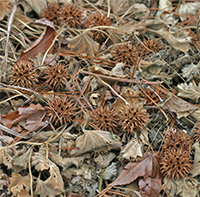 |
|
Rake old foliage and other debris from your garden.
|
Rake leaves and debris from your garden beds.
It is much easier to do this now before your spring bulbs come up and flower or the new growth begins on your perennials.
- Remove last year's dead foliage from hosta, daylilies, iris, and peonies. Clear this from the garden - do not compost it as it probably harbors insects and disease. Many compost piles do not get hot enough to kill these pests and diseases.
Watch Mark's video tip.
-
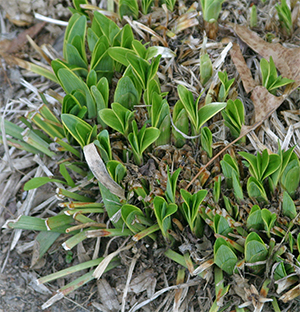 |
|
Cut Liriope back before the new growth begins.
|
Trim back the the winter ravaged foliage of evergreen perennials such as Helleborus, Epimedium, and Liriope. The fresh foliage of the new season will soon be poking up and it is much easier to give them a haircut before the new growth begins. This is especially true for Liriope. Once these begin to grow in the spring, it's difficult and time consuming to trim the old foliage.
Watch Mark's video tip.
- Trim the winter damaged foliage of boxwood branches (browned or whitened foliage) back to live growth in mid-March.
- Cut back ornamental grasses and other perennials left standing in the garden through the winter. Watch Mark's video tip.
Dealing with Snow Damage on Trees & Shrubs
Sometime this March, make a final assessment of winter injury on your trees and shrubs.
- If you have severe damage to boxwood, azalea, rhododendron, hollies, or yew, you may need to cut these back hard in March while they are still dormant. These plants have dormant buds in the bark and when pruned will produce new growth from these buds. They can be pruned to 24"-36" from the ground if necessary. See below ...
- Certain evergreens, such as pine, fir, spruce, arborvitae, and juniper, cannot be cut back hard because there are few or no dormant buds in the bark. Luckily, in most cases, these are fairly "snow resistant" and tend to spring back into shape when the snow melts. Here are some tips for pruning needled evergreens.
Early spring rejuvenation pruning
-
 |
|
American holly pruned to
bare branches
|
March is the time to do major heavy pruning of overgrown shrubs such as holly, boxwood, azalea, rhododendron, lilac, and yew. Instead of tearing them out and replacing these overgrown shrubs, cut them back hard now while they are still dormant. Because these plants have dormant buds on the interior bare wood close to the main stem, they can be pruned heavily until just bare branches remain or you can even cut them back to one to three feet above the ground. Check Mark's pruning videos.
- After severe pruning, fertilize your shrubs with Holly-tone, triple phosphate, and green sand according to the label directions.
Early spring thinning of trees and shrubs
- If they need thinning, you can thin out some branches of summer flowering trees now, but do not remove more than 20% of the live branches. Remove crossing branches and all dead and damaged wood.
-
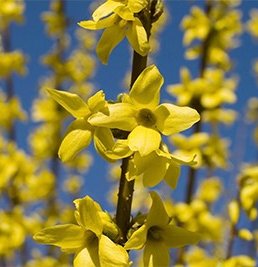 |
|
Forsythia blooms
|
You can also thin out some branches of forsythia, quince, and other spring flowering shrubs early this month while they are still dormant. Do not remove more than 10% - 20%. Bring some of the cut branches inside for a wonderful indoor flower display!
DO NOT shear them (give them a haircut) or you will loose the spring bloom. Any major pruning should be done right after they finish blooming.
Watch Mark's video tip.
- Wait until April to cut back Buddleia (butterfly bush) and Caryopteris.
Get a jump on pests and disease
- When nighttime temperatures are forecast to remain above 40°F. for 2-3 days, spray your fruit trees, roses, and other ornamental trees and shrubs with Bonide All Seasons Oil to smother overwintering insects, eggs, and immature insect
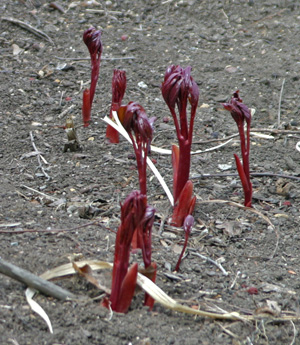 stages. stages.
Watch Mark's video tip.
- If your peonies were affected by botrytis last year, spray the emerging shoots with a fungicide like Bonide Mancozeb, Bonide Copper Fungicide, or Fung-onil.
Always read and follow the label directions!
|
|
|